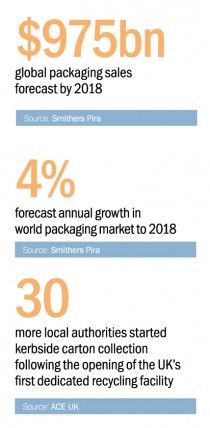Returning home with the shopping, an open-minded consumer approaches the packaging involved as an intrinsic and essential part of their purchase, something of value and benefit, rather than simply a potential “waste” problem. They experience the design, the craft, the manufacture. They enjoy the unwrapping; they more than like it, they love it. Sound familiar? No.
For most people, the reality is rather different: nine out of ten consumers worldwide are less than completely satisfied with the product packaging they encounter; 91 per cent of Canadians have experienced “wrap rage” or frustration with difficult-to-open packs; and four out of ten in the UK actually hurt themselves attempting to access goods in the last two years.
Demand for packaging is on the rise, however, with global markets forecast to hit $975 billion by 2018. If the general rule of thumb is that resource use and cost attributable to packaging amounts to approximately one tenth of the product itself, what would it take for us to learn to love the 10 per cent?
Some myth-busting might help. For example, 88 per cent of people believe food packaging is a problem equal to, or bigger than, food waste itself. Wrong. The Love Food Hate Waste campaign shows annual UK emissions from the packaging (11 million tons of CO2) rank nowhere near those from food waste (17 million tons).
Positive benefits need to be reinforced, as packaging technologist at Marks & Spencer, Simon Oxley, explains: “Product waste has far greater environmental impact than the packaging it comes in. Packaging therefore needs to be designed to keep products as fresh as possible, for as long as possible.”
In response, come packaging solutions dubbed “active”, “smart” or “intelligent”. These can be designed to absorb food odours, retard oxygen migration, control in-pack humidity, monitor freshness and issue use-by alerts. All of which added functionality extends shelf life for the retailer, and means the usefulness and value of the packaging to the purchaser continues back in the kitchen.
When it does come to disposal and recycling, however, responsibility stretches far beyond individuals, argues Mr Oxley. “In order to give consumers clear direction when it comes to recycling, we need to align the whole packaging supply chain with local authorities and waste recovery resources – relying on consumers to ‘check local’ should not be a long-term option,” he says.
GAMECHANGING INVESTMENT
In some cases, major investment is the systemic gamechanger, plain and simple. Novelis has sunk more than $260 million into a plant in Germany for so-called evercan, the first beverage-can material guaranteed at least 90 per cent recycled. Also, last year saw the launch of the UK’s first dedicated beverage carton recycling facility, by The Alliance for Beverage Cartons and the Environment (ACE) UK.
Packaging solutions can be designed to absorb food odours, retard oxygen migration, control in-pack humidity, monitor freshness and issue use-by alerts
“Kerbside collection of cartons and UK recycling rates are already increasing,” says ACE UK chief executive Richard Hands. “Since the facility opened in September 2013, a further 30 – 7 per cent – of UK local authorities have started collecting.”
For packaging recycling infrastructure in general, the meteoric growth in omnichannel retailing will also prove a future factor, with multiple purchase, collection and delivery options, plus associated returns scenarios calling for reverse logistics. A myriad of primary, secondary and transit packaging permutations in play will make supply-chain trade-offs inevitable in terms of economy, efficiency and waste.
For the branding community chasing differentiation, the temptation is to call for packaging makeovers. However, change can bring risk as much as reward, in the experience of Robert Opie, consumer historian and founder of the Museum of Brands, Packaging and Advertising, celebrating its 30th anniversary.
“Inherently, the consumer doesn’t really like change. They get familiar with and trust brands, so are suspicious of visual disruption. Any packaging redesign must be done with caution, in instalments, rather than one massive leap,” he says.
Understanding consumer perspectives also motivates a more holistic approach to design, as Chris Sherwin, head of sustainability at Seymourpowell, explains. “The biggest mistake industry makes is splitting product and packaging design from each other. This leads to a poor, unintegrated experience for consumers. It usually means money invested in product development and cut in packaging,” he says.
“We should always remember that the stuff, the pack, the communications – it’s ‘all the product’ in the eyes of consumers.”
Of course, many innovative and luxurious examples of packaging success stories will shortly be experienced around the globe, as gift-giving season arrives – everything from personalised and interactive packaging, to containers that are edible.
Among the boxes and bows there will be wow-factor branding showpieces, such as Nike Air trainers in a bubble of air or water-resistant Festina watches immersed in water. Then, post-New Year revelry, overindulgers will tackle tamperproof caps, courtesy of the healthcare market.
In among all the festivities, spare a thought for the silent majority of more mundane packaging, just doing its job. Learn to love the 10 per cent.
GAMECHANGING INVESTMENT

